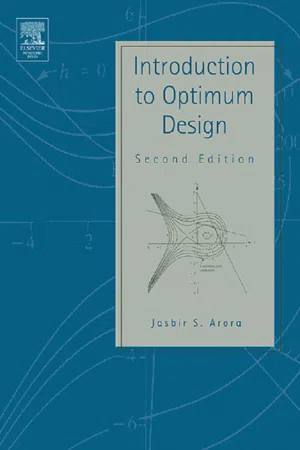
- 728 pages
- English
- ePUB (mobile friendly)
- Available on iOS & Android
Introduction to Optimum Design
About This Book
Optimization is a mathematical tool developed in the early 1960's used to find the most efficient and feasible solutions to an engineering problem. It can be used to find ideal shapes and physical configurations, ideal structural designs, maximum energy efficiency, and many other desired goals of engineering.
This book is intended for use in a first course on engineering design and optimization. Material for the text has evolved over a period of several years and is based on classroom presentations for an undergraduate core course on the principles of design. Virtually any problem for which certain parameters need to be determined to satisfy constraints can be formulated as a design optimization problem. The concepts and methods described in the text are quite general and applicable to all such formulations. Inasmuch, the range of application of the optimum design methodology is almost limitless, constrained only by the imagination and ingenuity of the user. The book describes the basic concepts and techniques with only a few simple applications. Once they are clearly understood, they can be applied to many other advanced applications that are discussed in the text.
- Allows engineers involved in the design process to adapt optimum design concepts in their work using the material in the text
- Basic concepts of optimality conditions and numerical methods are described with simple examples, making the material high teachable and learnable
- Classroom-tested for many years to attain optimum pedagogical effectiveness
Frequently asked questions
Information
Table of contents
- Cover image
- Title page
- Table of Contents
- Copyright
- Jasbir S. Arora
- Dedication
- Preface
- Chapter 1: Introduction to Design
- Chapter 2: Optimum Design Problem Formulation
- Chapter 3: Graphical Optimization
- Chapter 4: Optimum Design Concepts
- Chapter 5: More on Optimum Design Concepts
- Chapter 6: Linear Programming Methods for Optimum Design
- Chapter 7: More on Linear Programming Methods for Optimum Design
- Chapter 8: Numerical Methods for Unconstrained Optimum Design
- Chapter 9: More on Numerical Methods for Unconstrained Optimum Design
- Chapter 10: Numerical Methods for Constrained Optimum Design
- Chapter 11: More on Numerical Methods for Constrained Optimum Design
- Chapter 12: Introduction to Optimum Design with MATLAB
- Chapter 13: Interactive Design Optimization
- Chapter 14: Design Optimization Applications with Implicit Functions
- Chapter 15: Discrete Variable Optimum Design Concepts and Methods
- Chapter 16: Genetic Algorithms for Optimum Design
- Chapter 17: Multiobjective Optimum Design Concepts and Methods
- Chapter 18: Global Optimization Concepts and Methods for Optimum Design
- Appendix A: Economic Analysis
- Appendix B: Vector and Matrix Algebra
- Appendix C: A Numerical Method for Solution of Nonlinear Equations
- Appendix D: Sample Computer Programs
- References
- Bibliography
- Answers to Selected Problems
- Index